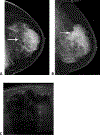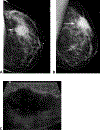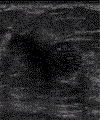Imaging Features of Triple Negative Breast Cancer and the Effect of BRCA Mutations
- PMID: 32033821
- PMCID: PMC7340565
- DOI: 10.1067/j.cpradiol.2020.01.011
Imaging Features of Triple Negative Breast Cancer and the Effect of BRCA Mutations
Abstract
Objective: The purpose of this study is to review the mammographic and the ultrasound features of triple negative breast cancer (TNBC) patients and to investigate the potential effect of BRCA mutations on the imaging features of these patients.
Methods: One hundred and seven patients with TNBC were enrolled in a retrospective study following IRB approval and approval of waiver of informed consent. BRCA mutations were assessed using genetic testing. Imaging features on mammography and ultrasound (US) as well as pathology and clinical information were retrospectively reviewed and characterized according to the BI-RADS lexicon (fifth edition). The relationships between BRCA mutations and the imaging findings were examined.
Results: TNBC commonly presented as an irregular mass with obscured margins on mammography and as an irregular hypoechoic mass with microlobulated or angular margins on US. Approximately two thirds of TNBC cases had a parallel orientation and approximately one third had posterior enhancement, features often associated with benign masses. There was no statistically significant difference in the mammographic and the US features of BRCA positive and BRCA negative triple negative tumors.
Conclusion: TNBC may have a parallel orientation and posterior enhancement, which are features often seen with benign masses. BRCA mutations do not affect the imaging features of triple negative breast tumors.
Copyright © 2020 Elsevier Inc. All rights reserved.
Conflict of interest statement
Conflict of Interest: The authors declare that they have no conflict of interest.
Figures





References
-
- Dent R, Trudeau M, Pritchard KI, et al. Triple-negative breast cancer: clinical features and patterns of recurrence. Clin Cancer Res 2007; 13:4429–4434 - PubMed
-
- Dogan BE, Turnbull LW. Imaging of triple-negative breast cancer. Ann Oncol 2012; 23 Suppl 6:vi23–29 - PubMed
-
- Ko ES, Lee BH, Kim HA, Noh WC, Kim MS, Lee SA. Triple-negative breast cancer: correlation between imaging and pathological findings. Eur Radiol 2010; 20:1111–1117 - PubMed
Publication types
MeSH terms
Grants and funding
LinkOut - more resources
Full Text Sources
Other Literature Sources

